Heat Stroke Prevention in Hot Specific Occupational Environment Enhanced by Supervised Machine Learning with Personalized Vital Signs
Abstract
:1. Introduction
2. Heat Stroke Prevention Method with Personalized Vital Signs
2.1. Proposed pHST Index
2.2. Heart Rate Detection with Canceling Motion Artifact
2.3. Activity Amount
2.4. Web Survey-Based Automatic Annotation for Supervised Machine Learning
3. Methods
4. Results
4.1. Features, Classifiers, and Evaluation Indexes for Supervised Machine Learning
4.2. Experimental Results
5. Discussion
6. Conclusions
- This paper proposed a personalized vital sign index by combining several types of vital data, which could efficiently prevent a heat stroke for persons in a hot working place. In particular, we improved the quality of the WBGT index as a pHST to consider the perceived temperature in the heterogeneous temperature and humidity distribution.
- To address the difficulty of corresponding the relevance of vital data to the degree of heat stroke, an automatic annotation system was developed for realizing supervised machine learning-based heat stroke prevention.
- The performance of heat stroke prevention for different types of supervised machine learning algorithms was experimentally evaluated in a hot and high-humidity specific working environment: A train maintenance factory in August in Japan.
Author Contributions
Funding
Institutional Review Board Statement
Informed Consent Statement
Conflicts of Interest
Abbreviations
| WBGT | Wet-Bulb Globe Temperature |
| pHST | Personalized Heat Strain Temperature |
| MA | Motion Artifacts |
| PPG | Photoplethysmography |
| LTE | Long-Term Evolution |
| HR | Heart Rate |
| KNN | k-Nearest Neighbor |
| SVM | Support Vector Machine |
| TPR | True Positive Rate |
| TNR | True Negative Rate |
| FNR | False Negative Rate |
| FPR | False Positive Rate |
References
- Yaglou, C.P.; Minard, C.D. Control of heat casualties at military training centers. Amer. Med. Assoc. Arch. Ind. Health 1957, 16, 302–316. [Google Scholar]
- Morabito, M.; Messeri, A.; Noti, P.; Casanueva, A.; Crisci, A.; Kotlarski, S.; Orlandini, S.; Schwierz, C.; Spirig, C.; Kingma, B.R.M.; et al. An occupational heat-health warning system for Europe: The HEAT-SHIELD platform. Int. J. Environ. Res. Public Health 2019, 16, 2890. [Google Scholar] [CrossRef] [PubMed] [Green Version]
- Tips to Keep Workers Safe in the Heat. Available online: http://blog.dol.gov/2020/06/19/6-tips-to-keep-workers-safe-in-the-heat (accessed on 1 January 2021).
- Lemke, B.; Kjellstrom, T. Calculating workplace WBGT from meteorological data: A tool for climate change assessment. Ind. Health 2012, 50, 267–278. [Google Scholar] [CrossRef] [PubMed] [Green Version]
- McGregor, G. Special issue: Universal thermal climate index (UTCI). Int. J. Biometeorol. 2012, 56, 419–555. [Google Scholar] [CrossRef] [PubMed]
- Fox, R.H.; Solman, A.J. A new technique for monitoring the deep body temperature in man from the intact skin surface. J. Physiol. 1971, 212, 8–10. [Google Scholar]
- Kitamura, K.; Zhu, X.; Chen, W.; Nemoto, T. Development of a new method for the noninvasive measurement of deep body temperature without a heater. Med. Eng. Phys. 2009, 32, 1–6. [Google Scholar] [CrossRef] [PubMed]
- ISO7243; Ergonomics of the Thermal Environment–Assessment of Heat Stress Using the WBGT (Wet Bulb Globe Temperature) Index. International Organization for Standardization: Geneva, Switzerland, 2017.
- JIS Z 8504; Estimation of the Heat Stress on Working Man, Based on the WBGT-Index (Wet Bulb Globe Temperature)–Hot Environments. Japanese Industrial Standards: Tokyo, Japan, 1999.
- Ministry of the Environment, Heat Stroke Alerts Have Been Issued. Available online: https://www.wbgt.env.go.jp/en/ (accessed on 26 May 2021).
- Kaiho, Y.; Takamatsu, S.; Itoh, T. Method of estimating heatstroke risk using wristwatch-type device. Sens. Mater. 2019, 31, 4061–4068. [Google Scholar] [CrossRef] [Green Version]
- McCann, D.J.; Adams, W.C. Wet bulb globe temperature index and performance in competitive distance runners. Med. Sci. Sport. Exerc. 1997, 29, 955–961. [Google Scholar] [CrossRef]
- HEAT SHIELD. Available online: https://heatshield.zonalab.it/ (accessed on 26 May 2021).
- Bass, D.E.; Kleeman, C.R.; Quinn, M.; Henschel, A.; Hegnauer, A.H. Mechanisms of acclimatization to heat in man. Medicine 1955, 34, 323–380. [Google Scholar] [CrossRef] [PubMed]
- Nielsen, B. Heat acclimation–mechanisms of adaptation to exercise in the heat. Int. J. Sports Med. 1998, 19 (Suppl. S2), S154–S156. [Google Scholar] [CrossRef] [PubMed]
- ACGIH (American Conference of Governmental Industrial Hygienists). Heat Stress and Strain TLV; ACGIH: Washington, DC, USA, 2012. [Google Scholar]
- Asayama, M. Guideline for the prevention of heat disorder in Japan. Glob. Environ. Res. 2010, 13, 19–25. [Google Scholar]
- Ono, M.; Tonouchi, M. Estimation of wet-bulb globe temperature using generally measured meteorological indices. Jpn. J. Biometeorol. 2014, 50, 147–157. [Google Scholar]
- Hämäläinen, M.; Mucchi, L.; Girod-Genet, M.; Paso, T.; Farserotu, J.; Tanaka, H.; Anzai, D.; Pierucci, L.; Khan, R.; Alam, M.M.; et al. ETSI SmartBAN architecture: The global vision for smart body area networks. IEEE Access 2020, 8, 150611–150625. [Google Scholar] [CrossRef]
- Barry, N.N.; Dillingham, M.F.; McGuire, J.L. Nonsurgical Sports Medicine: Preparticipation Exam through Rehabilitation; John Hopkins University Press: Baltimore, MD, USA, 2002; pp. 290–292. [Google Scholar]
- Shimazaki, T.; Hara, S.; Okuhata, H.; Nakamura, H.; Takashi, K. Cancellation of motion artifact induced by exercise for PPG-based heart rate sensing. In Proceedings of the 36th Annual International Conference of the IEEE Engineering in Medicine and Biology Society (EMBC 2014), Chicago, IL, USA, 26–30 August 2014; pp. 3216–3219. [Google Scholar]
- Shimazaki, T.; Hara, S.; Okuhata, H.; Nakamura, H.; Takashi, K. Motion artifact cancellation and outlier rejection for clip-type PPG-based heart rate sensor. In Proceedings of the 37th Annual International Conference of the IEEE Engineering in Medicine and Biology Society (EMBC2015), Milan, Italy, 25–29 August 2015; pp. 2026–2029. [Google Scholar]
- Ministry of the Environment, Heat illness Prevention Information. Available online: https://www.wbgt.env.go.jp/record_data.php?region=07&prefecture=62&point=62078 (accessed on 16 February 2021).

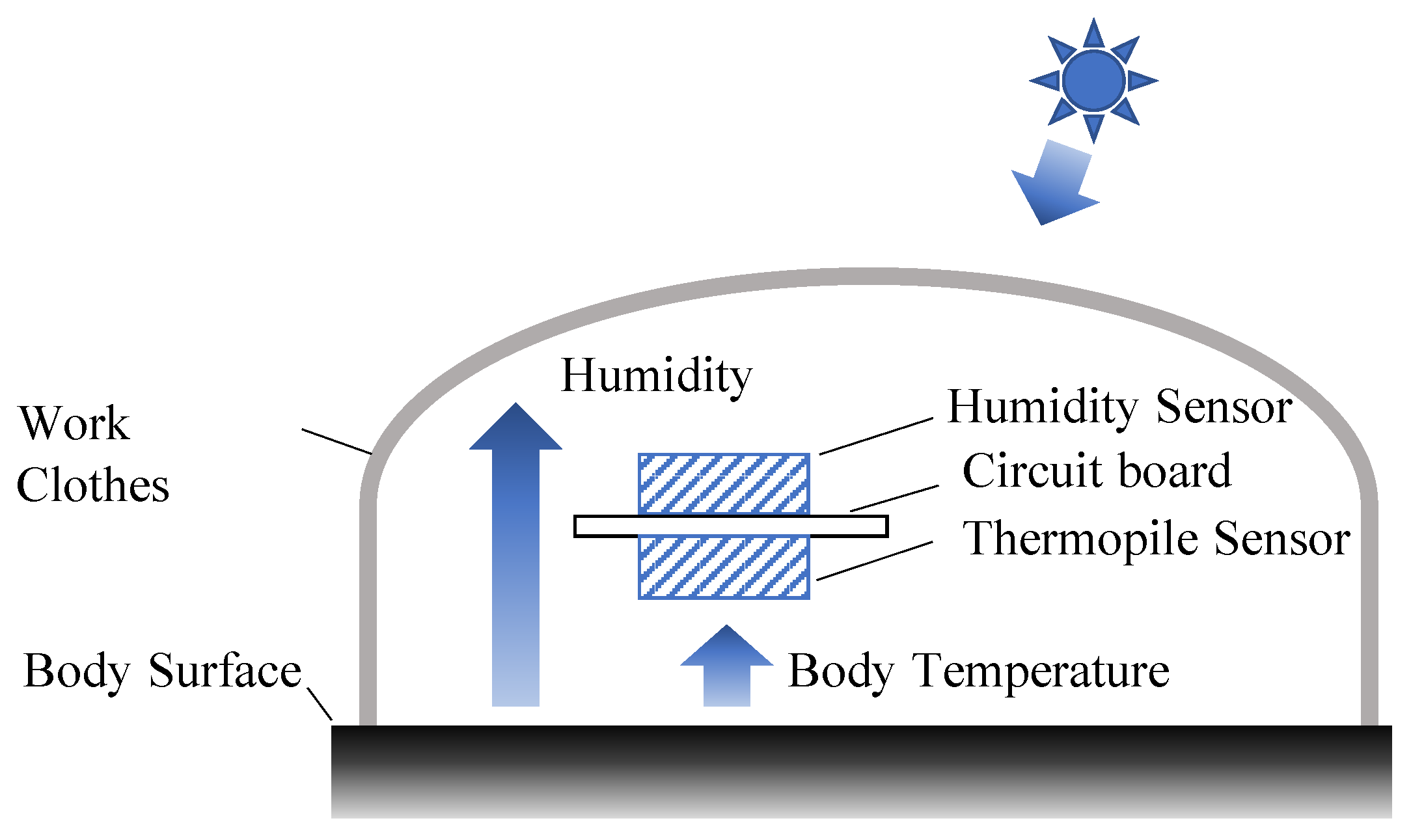


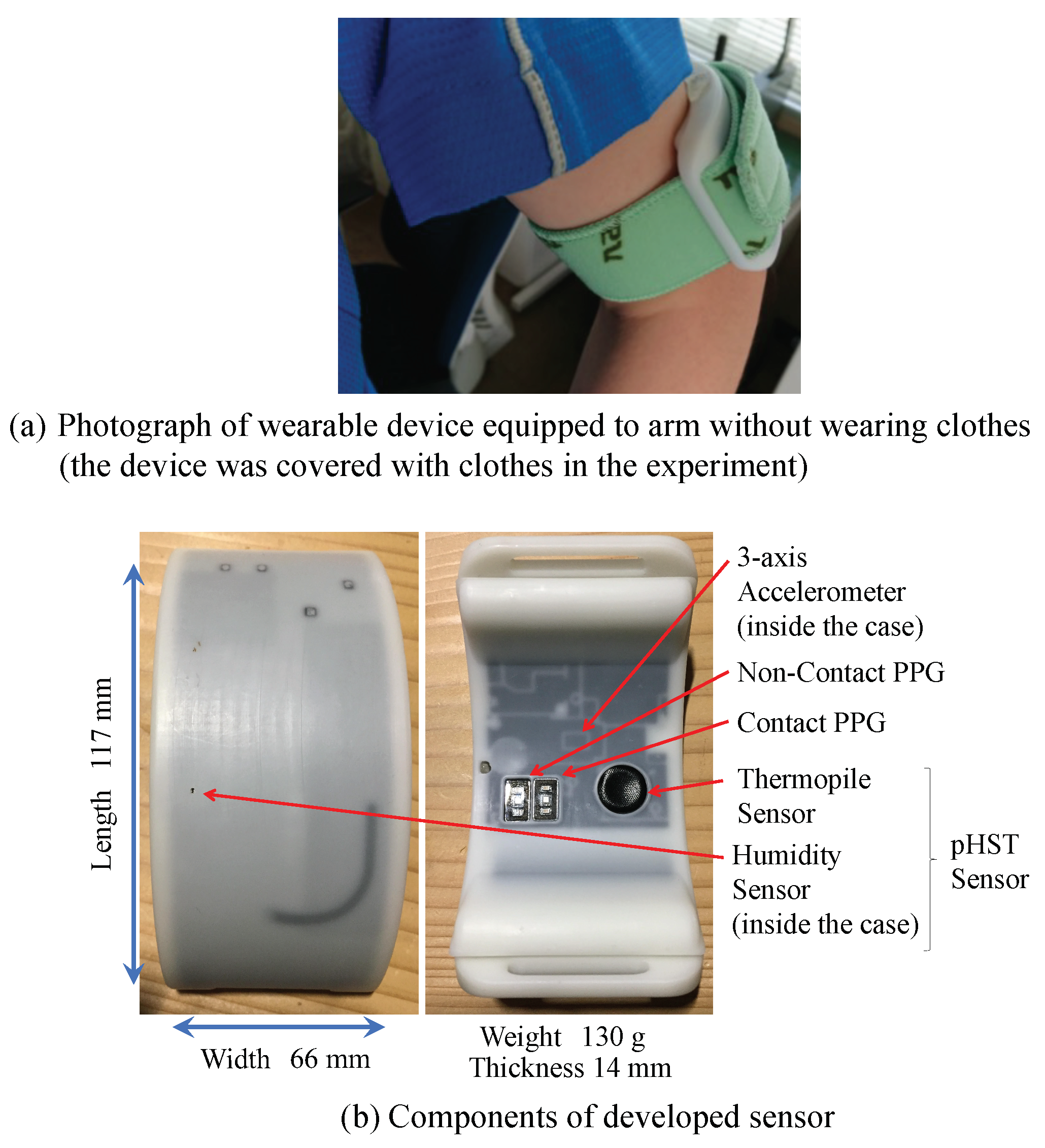
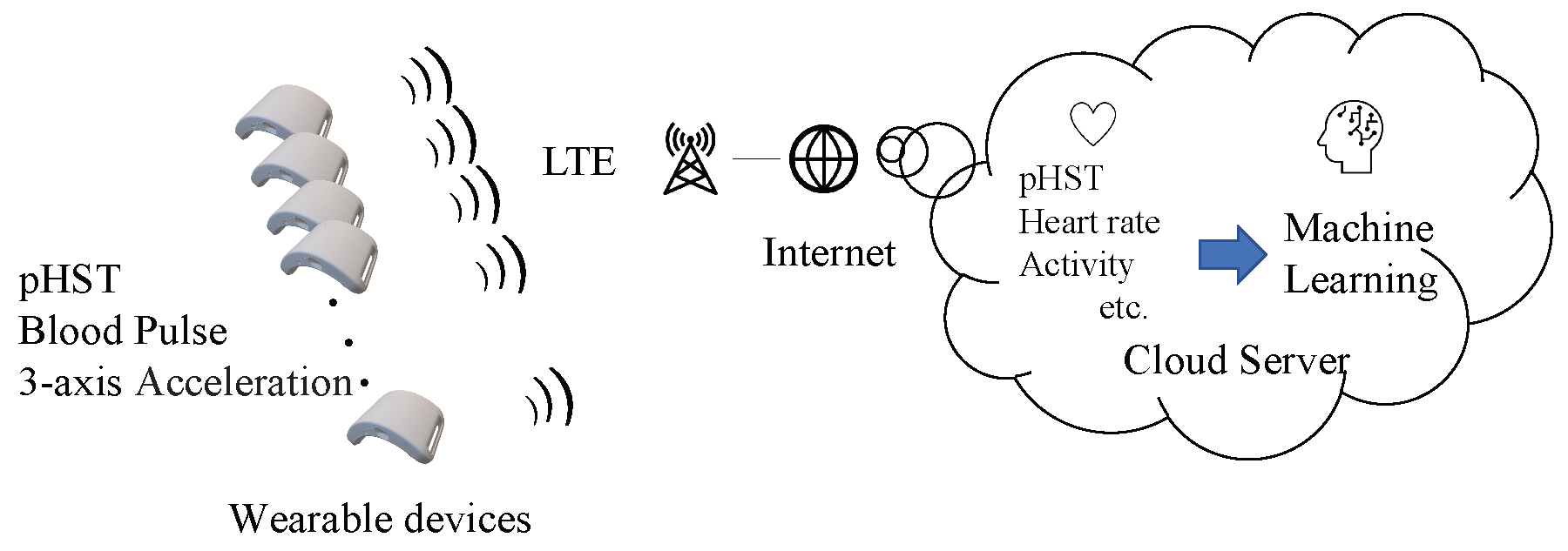
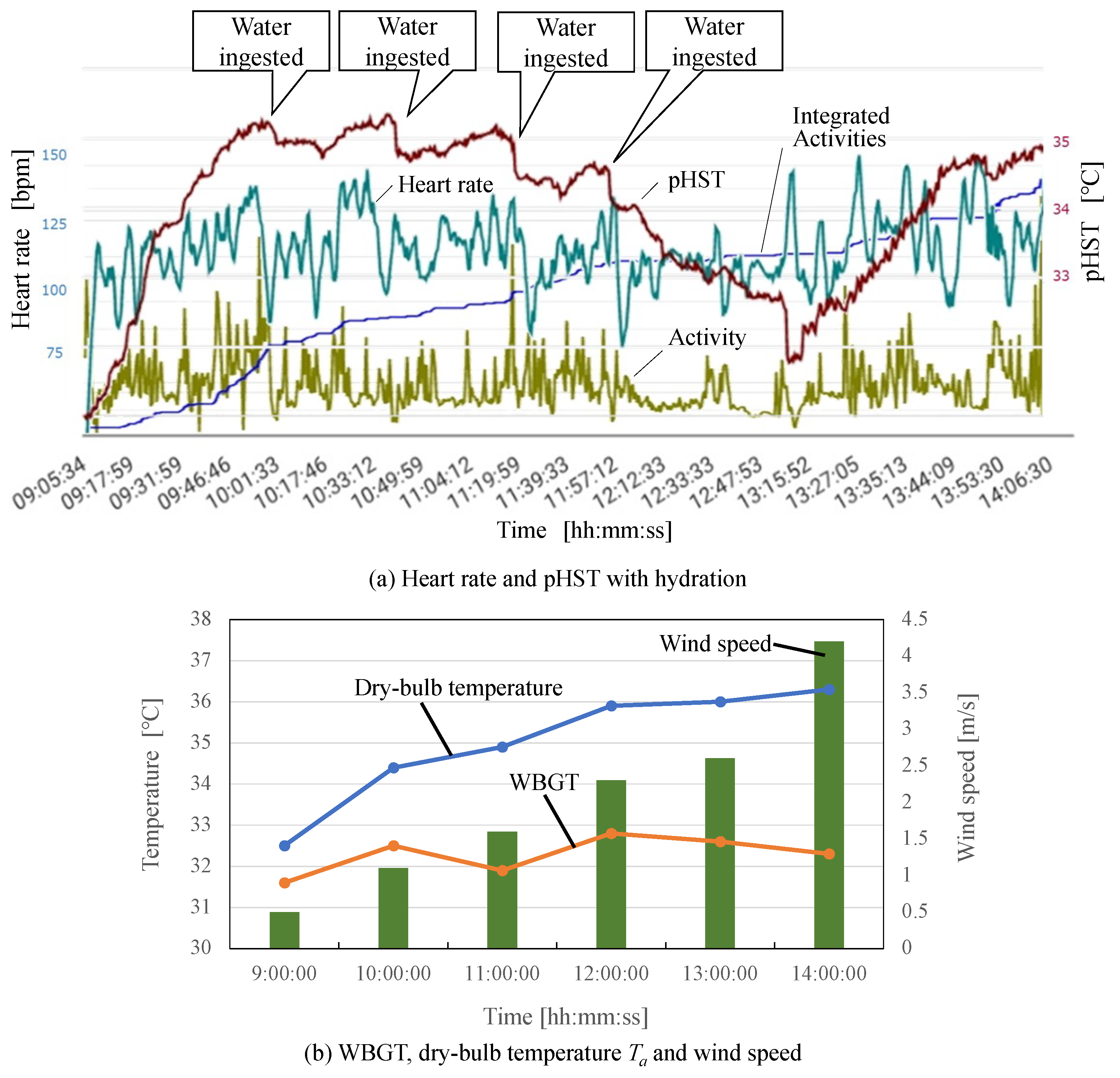
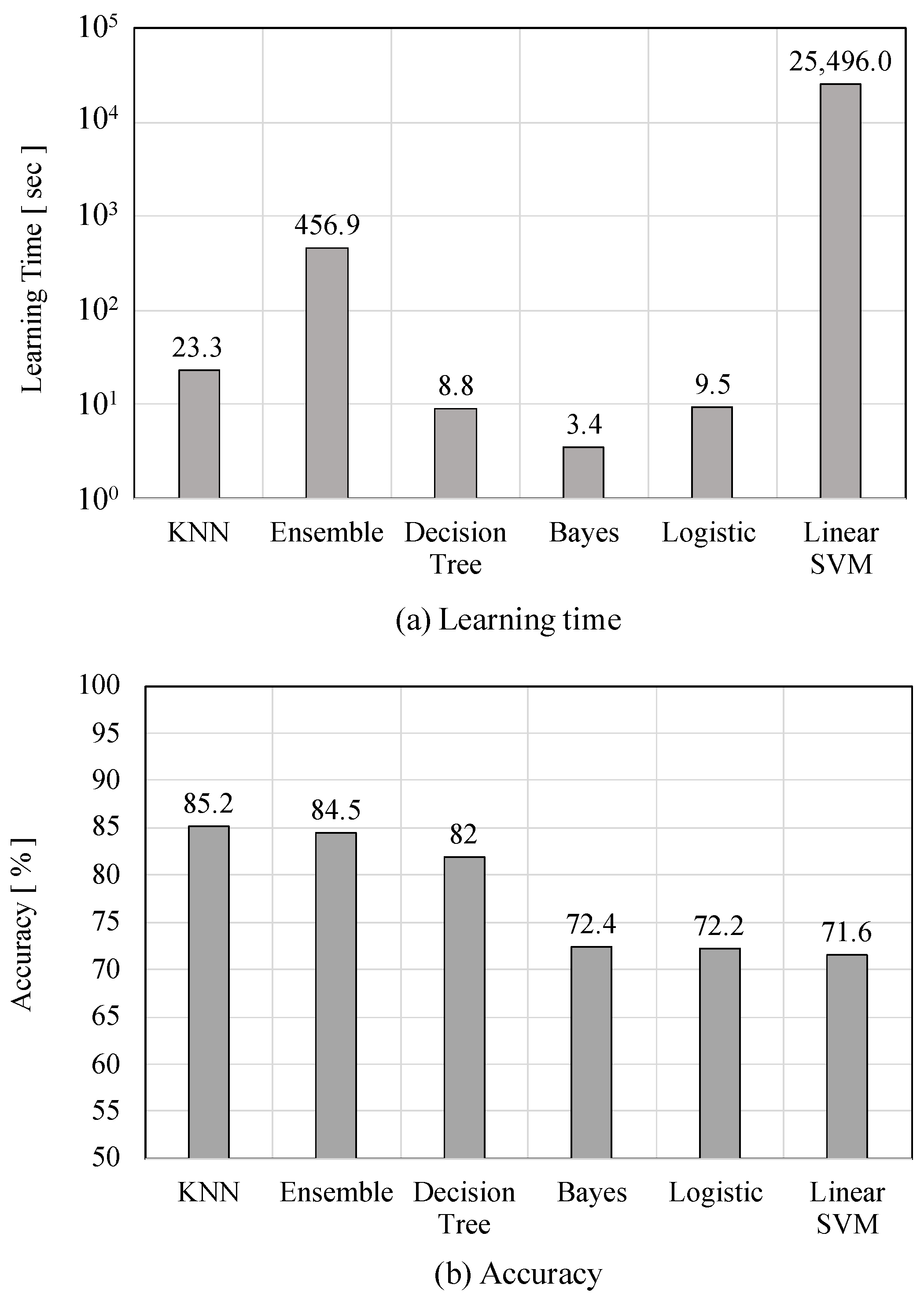
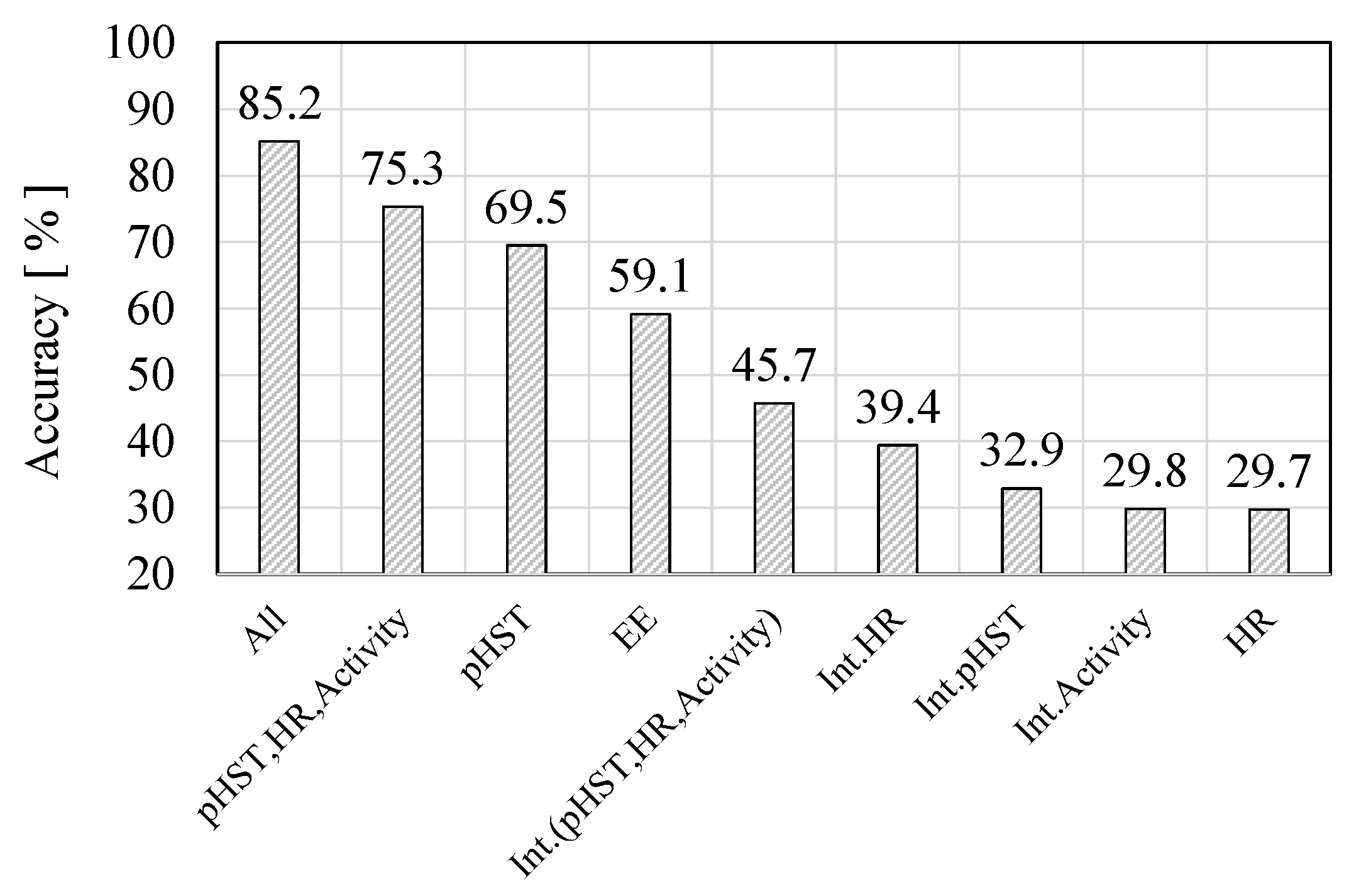

| Parts | Model Number | Features |
|---|---|---|
| Optical sensor IC for heart rate monitor | BH1790GLC-E2 | Pulse wave |
| Optical sensor IC for heart rate monitor | BH1790GLC-E2 | Motion artifact cancellation |
| Thermopile | MLX90614ESF-BCC-000-TU | Body surface temperature |
| Humidity-temperature sensor | Si7021-A20-IM1 | Humidity and temperature in clothes |
| Inertial measurement unit | MPU-9250 | 3-axis acceleration |
| Wireless module | 4GIM V1.0 | Long term evolution (LTE) |
| Lithium-ion battery | DTP603450 | (available for up to 10 h) |
| 3 Aug. | 4 Aug. | 5 Aug. | 6 Aug. | 7 Aug. | 10 Aug. | 11 Aug. | 12 Aug. | |
|---|---|---|---|---|---|---|---|---|
| WBGT | - | - | - | - | - | indicated | indicated | indicated |
| pHST | indicated | indicated | indicated | indicated | indicated | - | indicated | indicated |
| Survey | - | indicated | indicated | indicated | - | - | - | indicated |
| 14 Aug. | 15 Aug. | 16 Aug. | 17 Aug. | 18 Aug. | 19 Aug. | 20 Aug. | 21 Aug. | |
| WBGT | indicated | indicated | indicated | indicated | - | - | indicated | indicated |
| pHST | - | - | - | indicated | indicated | indicated | indicated | indicated |
| Survey | - | - | - | indicated | indicated | indicated | indicated | indicated |
| 22 Aug. | 24 Aug. | 25 Aug. | 27 Aug. | 28 Aug. | 29 Aug. | 30 Aug. | 31 Aug. | |
| WBGT | indicated | - | indicated | indicated | indicated | indicated | indicated | indicated |
| pHST | - | indicated | - | - | - | - | - | - |
| Survey | - | indicated | - | - | - | - | - | - |
Publisher’s Note: MDPI stays neutral with regard to jurisdictional claims in published maps and institutional affiliations. |
© 2022 by the authors. Licensee MDPI, Basel, Switzerland. This article is an open access article distributed under the terms and conditions of the Creative Commons Attribution (CC BY) license (https://creativecommons.org/licenses/by/4.0/).
Share and Cite
Shimazaki, T.; Anzai, D.; Watanabe, K.; Nakajima, A.; Fukuda, M.; Ata, S. Heat Stroke Prevention in Hot Specific Occupational Environment Enhanced by Supervised Machine Learning with Personalized Vital Signs. Sensors 2022, 22, 395. https://doi.org/10.3390/s22010395
Shimazaki T, Anzai D, Watanabe K, Nakajima A, Fukuda M, Ata S. Heat Stroke Prevention in Hot Specific Occupational Environment Enhanced by Supervised Machine Learning with Personalized Vital Signs. Sensors. 2022; 22(1):395. https://doi.org/10.3390/s22010395
Chicago/Turabian StyleShimazaki, Takunori, Daisuke Anzai, Kenta Watanabe, Atsushi Nakajima, Mitsuhiro Fukuda, and Shingo Ata. 2022. "Heat Stroke Prevention in Hot Specific Occupational Environment Enhanced by Supervised Machine Learning with Personalized Vital Signs" Sensors 22, no. 1: 395. https://doi.org/10.3390/s22010395
APA StyleShimazaki, T., Anzai, D., Watanabe, K., Nakajima, A., Fukuda, M., & Ata, S. (2022). Heat Stroke Prevention in Hot Specific Occupational Environment Enhanced by Supervised Machine Learning with Personalized Vital Signs. Sensors, 22(1), 395. https://doi.org/10.3390/s22010395






